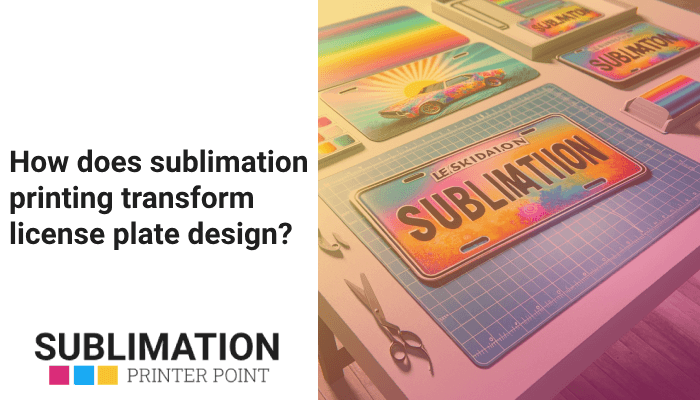The sublimation method on license plates allows you to create a unique look for your plates using printing. The technique deftly uses pressure and heat to convert computer images onto polyester fabric or polymer-coated objects.
Sublimation printing is a cutting-edge method that transfers graphics from paper to cloth by applying pressure and heat. The procedure produces brilliant, long-lasting prints that won’t peel or fade. It includes printing a computer picture onto sublimation paper using sublimation ink. A heat press machine, sublimation ink, sublimation paper, and a sublimation printer are essential parts of this procedure. Because the prints are weatherproof and intricate, multicolored images can be created, this procedure works especially well for personalized license plates.
- Sublimation printing is a process that uses heat and pressure to transfer designs from paper to fabric.
- The process involves a digital image printed onto sublimation paper with sublimation ink.
- Key components include a sublimation printer, sublimation ink, sublimation paper, and a heat press machine.
- The prints are vibrant, durable, and can withstand the elements.
- This process is particularly effective for creating custom license plates, allowing for complex, multi-colored designs.
What is sublimation printing and how does it work?
Using pressure and heat, the innovative sublimation printing method transfers designs from paper to fabric. A digital image created with sublimation ink on sublimation paper is the first step in the process. There are particular sublimation dyes in this ink. These dyes skip the liquid stage and become a gas when heated. The gas can penetrate the polyester fabric or polymer-coated object because of the high temperature, which opens up the pores. The pores close when the heat source is withdrawn, keeping the dye within. This produces a vivid, durable print that is resistant to peeling and fading. To create personalized automobile tags and custom sublimation license plates, it is essential to comprehend this technique.
What are the key components of sublimation printing?
A heat press machine, sublimation ink, sublimation paper, and a sublimation printer are the essential parts of sublimation printing. The design is printed onto sublimation paper using a printer that is loaded with sublimation ink—typically an Epson EcoTank. The polyester cloth or polymer-coated object, such a license plate, is then covered with this paper. The ink sublimates and penetrates the object thanks to the heat press machine’s use of pressure and heat. These materials are necessary to create dye-sublimation vehicle plates and heat transfer license plates.
How does heat transfer play a role in sublimation printing?
The foundation of sublimation printing is heat transfer. The process known as sublimation occurs when the catalyst converts the solid sublimation dyes into gas without going through a liquid phase. The gas can enter the polyester fabric or polymer-coated object because the heat causes the pores to open. The pores close when the heat is withdrawn, keeping the dye inside. A bright, long-lasting print is produced as a result. To achieve the best transfer when sublimating license plates, the heat press machine’s temperature needs to be adjusted to about 385 degrees.
Did you know that sublimation printing frequently uses the heat-resistant material Nomex? It contributes to the uniform distribution of heat across the license plate, guaranteeing a clear and consistent print. This is particularly crucial when making personalized license plates made of sublimation.
What is the role of sublimation ink and sublimation paper in the process?
The sublimation printing procedure requires both sublimation ink and paper. The paper acts as a medium to transmit the design onto the item, and the ink contains unique colors that have the ability to sublimate. Using the ink, the pattern is first printed onto the sublimation paper. The ink on the paper becomes a gas when heated, and this gas penetrates the object to produce a vivid, durable print. For DIY sublimation on license plates and personalized sublimated license plates, this procedure is necessary.
How is sublimation printing applied to license plate design?
In order to apply sublimation printing to license plate designs, a digital image must first be printed using sublimation ink onto sublimation paper. The license plate, which is usually composed of aluminum and coated with a unique polymer that can absorb the sublimation dyes, is then covered with the paper. The ink is sublimated and penetrates the license plate with the application of heat and pressure using a heat press equipment. It’s perfect for generating personalized sublimation license plates and sublimation procedures for license plates since it produces a bright, weatherproof print.
What are the benefits of using sublimation printing for custom license plates?
There are several advantages to sublimation printing for personalized license plates. Withstanding weather conditions without peeling or fading, the prints are vivid and long-lasting. This is because the ink is not just sitting on top of the license plate; it is actually soaking into it. Sublimation printing is perfect for personalized car tags since it can also produce intricate, multicolored graphics that are simple to duplicate. Moreover, the procedure is comparatively rapid and effective, enabling large-scale manufacturing. Due to these advantages, sublimation printing is a preferred method for producing dye-sublimation vehicle plates and heat transfer license plates.
How does the sublimation process affect the durability of personalized license plates?
Personalized license plates are much more durable thanks to the sublimation technique. Sublimation ink penetrates the license plate, as opposed to conventional printing techniques where the ink lies on top of the surface, producing a print that is resistant to peeling, fading, and weathering. Because sublimation license plates are resistant to weather, they are perfect for usage outside. Additionally, even after extended use, the details and colors stay crisp. The popularity of personalized sublimation license plates and sublimation methods for license plates is largely due to their durability.
Consider using 8 1/2 x 14 inch paper when sublimation printing with an Epson EcoTank printer. This size allows for a full-coverage print because it can fit the typical license plate, which measures roughly 5.88 by 11.88 inches.
What are the considerations when applying sublimation coating on aluminium license plates?
Several things must be taken into account before sublimating an aluminum license plate. To guarantee a smooth and even coating, the license plate needs to be clean and clear of any debris. It is important to apply the coating uniformly to avoid any discrepancies in the final print. To guarantee ideal sublimation, the heat press machine must also be adjusted to the proper temperature and pressure. To create a vivid and durable print, it’s also critical to remember that the coating and sublimation ink must work well together. For DIY sublimation on license plates and personalized sublimated license plates, these factors are essential.
What equipment is needed for DIY sublimation on license plates?
Several items of equipment are needed for do-it-yourself license plate sublimation. Printing the design into sublimation paper with sublimation ink requires a sublimation printer, usually an Epson EcoTank. After that, pressure and heat are applied using a heat press machine, which causes the ink to sublimate and penetrate the license plate. Sublimation blanks are also required; these are materials ready for sublimation printing. An aluminum license plate covered in a certain polymer would serve as the blank in this scenario. In order to create personalized sublimation license plates and sublimation procedures for license plates, several tools are necessary.
What type of dye-sublimation printers are suitable for license plate design?
There are differences amongst dye-sublimation printers when it comes to designing license plates. The printer needs to be able to produce prints of the highest caliber, with clear details and brilliant colors. Epson EcoTank printers are frequently suggested because of their superior output quality and sublimation ink compatibility. The license plate is normally 5.88 inches by 11.88 inches, so the printer should also be able to handle that size. When making dye-sublimation vehicle plates or heat transfer license plates, certain factors must be taken into account.
How to choose the right heat press machine for sublimation on license plates?
There are various considerations while selecting the best heat press machine for sublimation on license plates. The device needs to be able to attain the required sublimation temperature, which is usually about 385 degrees. In order to guarantee an even transfer, it should also apply constant pressure. Furthermore, the heat press machine’s dimensions must coincide with the license plate’s dimensions. A range of heat press machines, such as the License Plate in the Heat Press Set, are available on Amazon that are appropriate for sublimating license plates. For DIY sublimation on license plates and personalized sublimated license plates, these factors are essential.
What are sublimation blanks and how are they used in the process?
Items that are ready for sublimation printing are known as sublimation blanks. Usually, polyester fabric or a polymer-coated material—such as aluminum for license plates—are used to make them. The sublimation paper with the design on it and the blank are put into the heat press machine. A vivid, long-lasting print is produced when the ink sublimates and penetrates the blank due to the machine’s heat and pressure. For the creation of personalized sublimation license plates and sublimation methods for license plates, sublimation blanks are a must.

How does sublimation printing contribute to automotive decorations?
Because it makes it possible to create unique, colorful, and long-lasting graphics, sublimation printing makes a significant contribution to automobile decorations. This is especially true for license plates, where weather-resistant personalized automobile tags are made possible via sublimation printing. However, license plates are not the only possible use. There are countless ways to customize items like seat coverings, car mats, and other accessories with sublimation printing. Heat transfer license plates and dye-sublimation vehicle plates are two common automotive decorations made possible by the adaptability and durability of sublimation printing.
What are the possibilities of sublimation printing in car accessories?
There are endless options when it comes to automotive accessories with sublimation printing. Sublimation printing is not just for license plates; it can also be used to make personalized seat coverings, key chains, and car mats. Complex, multicolored graphics that are vivid and long-lasting can be created with this method. This implies that automobile owners can add customized touches to their cars that express their distinct sense of fashion and individuality. Additionally, because sublimation prints are resilient and can tolerate normal wear and tear, they are perfect for usage in automobiles. Because of these options, sublimation printing is becoming a popular option for vehicle decorations, such as DIY sublimation on license plates and personalized sublimated license plates.
How can graphic design techniques enhance sublimation products for vehicles?
Vehicle sublimation goods can be substantially improved with the use of graphic design approaches. Designers may effortlessly put intricate, multicolored graphics onto a number of automotive accessories, such as license plates, by using software such as Adobe Illustrator or Photoshop. Text effects, gradients, and layering are a few techniques that can give designs more depth and appeal. Color theory can also be used to make sure that the designs are eye-catching and noticeable from the road. The attractiveness of personalized sublimation license plates and sublimation methods for license plates can be improved with these methods.
How does sublimation printing influence trends in vehicle registration plates?
Trends in car registration plates are greatly influenced by sublimation printing. The popularity of custom sublimation license plates has increased due to the ability to produce vivid, robust, and personalized patterns. Sublimation printing gives car owners the opportunity to show their personality via their vehicle in a way that is distinctive and creative—something that is becoming more and more popular. The options are endless, ranging from advertising a business to highlighting a beloved sports team. Sublimation printing will undoubtedly play a significant role in the future of automobile registration plates due to the likelihood that this trend toward customisation will continue.

